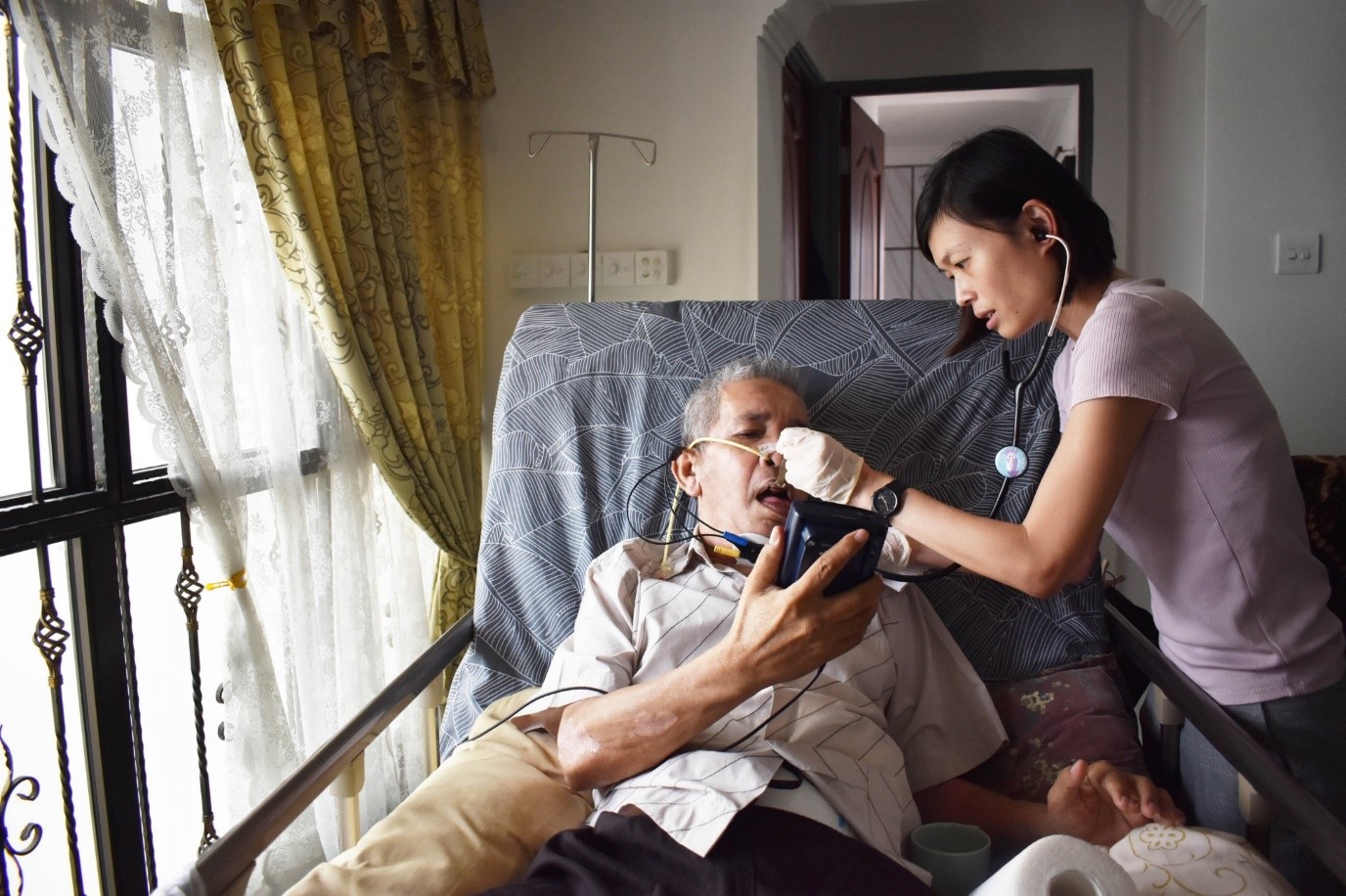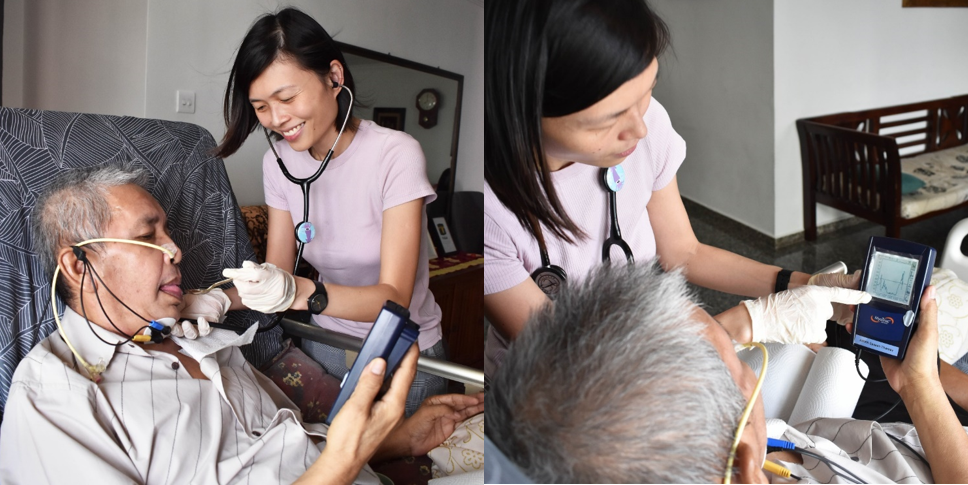Speech Therapy at Home

While speech therapy is not as well-known as other forms of therapy, this care service – which is available to home-bound clients too – provides benefits that extend beyond improving the ability to speak.
Beside a window that overlooks the serene Pandan Reservoir, Mr Abdullah, 64 years old, is propped up by pillows on his hospital bed. Mr Abdullah, who used to work as a switchboard operator, had a brain stem stroke in 2018 that caused him to lose the ability to swallow and communicate effectively. He also needed assistance from his family to perform some of the Activities of Daily Living such as showering and toileting.
When his wife Mdm Saleha lets in AWWA Speech Therapist Ms Lim Yujun, Mr Abdullah gently waves ‘hello’ to Yujun with his right hand which is still strong. This is his eighth speech therapy session with Yujun.
Yujun, who joined the Community Care sector after practising in acute hospitals for six years, unpacks a case and begins setting up while catching up with Mr Abdullah on how he has been and how he is feeling. Mr Abdullah has dysarthria – a motor speech disorder arising from the stroke which slows and slurs speech. He communicates through Augmentative Alternative Communication (AAC) using gestures and an alphabet board which he points at, to spell words.
What is Speech Therapy?
Speech therapy is the assessment, management and treatment of swallowing, and communication disorders. Clients with communication disorders can experience difficulty in language, speech, voice, fluency, or cognitive communication issues.
Due to the nature of these disorders, speech therapists can serve clients ranging from infants to the elderly. Yujun, however, serves mostly adults and seniors who have neurological conditions like stroke, Parkinson’s disease, or dementia. She has also seen clients with head and neck cancer, or brain tumours, as these conditions often affect their ability to swallow and communicate.
“My job is primarily to restore and maximise functions, and recommend compensatory strategies if restoration is not possible. I have been using Surface Electromyography (SEMG) with Mr Abdullah to improve his swallowing function. Despite being home-bound and unable to access outpatient services, he can still access intensive rehabilitation at home.”

The SEMG is a handheld device that is roughly the size of a NETS terminal. Yujun begins by attaching an adhesive electrode patch to Mr Abdullah’s chin. The electrodes pick up electrical muscle activity, which translates to a line graph on the device. Mr Abdullah attempts to improve his swallowing effort by reaching or surpassing horizontal line running across the screen which signifies the target amplitude determined for him.
“Good try,” Yujun affirms with Mr Abullah’s every attempt.
The determination on Mr Abdullah’s face is evident as he focuses his attention on the monitor’s reading. Yujun encourages him constantly to “aim for the line”. It is not an easy target but Mr Abdullah does not waver from the screen and maintains a positive attitude. Each time the reading surpasses the line, he glows with satisfaction.
Benefits of the Home Setting
There are some differences in the way speech therapists like Yujun work when in a centre compared to a client’s home.
“In a client’s home, I rely on the client or their caregiver to navigate their home environment. These subtleties improve the interaction between me and my clients, making the work more enjoyable and fulfilling for me,” she says.
Home therapy also supports an inter-disciplinary team approach.
“For home therapy, I can be the eyes and ears for my allied health colleagues to identify and resolve issues faced by the client at home as quickly as possible. Furthermore, as we are acquainted with the client’s home environment, we can make recommendations that are tailored to their everyday needs and limitations,” says Yujun.
For clients who experience swallowing difficulties, caregivers tend to struggle with food choices at home because they are unsure what to cook. Yujun often advises caregivers on diet modifications to suit the soft, minced or pureed diet requirements of clients.
Challenges Home Care Professionals Overcome
Yujun explains that it’s not easy to keep improvising solutions within the home environments of different clients. In addition, the commute to and fro the homes of different clients can be tiring as a home-based therapist. However, despite the challenges, Yujun finds her job fulfilling in many other ways.
What keeps her going is the personal relationships that she has built with her clients.
“I have always enjoyed providing home therapy, because of the deeper rapport that I build with my clients.”
She’s also working to overcome the language barrier. Mr Abdullah’s wife and son, who speak English, have gamely taught her a few Malay words so she can better communicate with Mr Abdullah.

Ultimately, therapy outcomes are dependent on many factors such as the client’s condition, internal motivation to participate in rehabilitation and the support received from family and community.
Mr Abdullah’s condition has improved since beginning his therapy journey. He can now better initiate swallows and Yujun hopes to eventually help him reach his goal of resuming eating and drinking.
By the end of the hour-long session, Mr Abdullah looks spent but pleased with himself.
“Good job today,” Yujun smiles and praises Mr Abdullah as she packs up her kit.
Mr Abdullah has difficulty smiling back but his thumbs up gesture says it all.
Home Speech Therapy costs between $125 to 186 per session (before subsidy). Subsidies are available for means-tested Singaporeans and PRs. For more information, please visit http://bit.ly/2qLeTxe.
